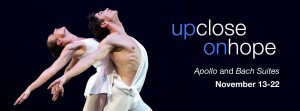 Festival Ballet Providence’s popular “Up Close On Hope” returns for yet another season. Set in the company’s intimate Black Box Theatre, audience members are treated to a unique viewing experience sitting just a few scant feet from the performers. The current offering takes this experience one step further by incorporating live music courtesy of Community Music Works.
Festival Ballet Providence’s popular “Up Close On Hope” returns for yet another season. Set in the company’s intimate Black Box Theatre, audience members are treated to a unique viewing experience sitting just a few scant feet from the performers. The current offering takes this experience one step further by incorporating live music courtesy of Community Music Works.
Though the program does not feature the traditional show stopping classical pas de deux followed by a coda that have highlighted past performances, it does cover a varied palette of themes sure to satisfy any dance fan’s appetite.
And while world, Rhode Island and company premieres fill the bill, the current installment also serves as a continuation of the yearlong farewell to one of the company’s most beloved dancers, Mindaugas Bauzys, who announced he will be retiring at season’s end. I do not think it would be a stretch to suggest that most in attendance where there to see him dance “Apollo.”
As one of Balanchine’s most iconic ballets, it is one that all male dancers want on their resume. And though Bauzys has danced this role before, it only seems fitting that he performs it one last time. Featuring the groundbreaking choreographer’s innovative neoclassical style, it is a complex and challenging role with intense physical and emotional demands.
Legendary dancer Rudolph Nureyev wanted so badly to dance “Apollo” that he personally wrote Balanchine informing him of his availability. Though Nureyev was at his apex, Balanchine was taken aback by the dancer’s arrogance in dictating his terms, so he famously replied, “When you are tired of playing at being a prince, come to me.” In other words, lose your airs and then we can talk.
During the opening weekend performances, Bauzys did not disappoint, delivering a stirring performance. Appearing initially as a brooding young child, Bauzys remarkably portrays Apollo’s evolution into a god, even injecting some humor; once Apollo completes his mastery of the arts with the aid of his three muses, Bauzys confidently orchestrates their movements across the floor while frantically nodding his head like that of an orchestra conductor.
With his lean, muscular body and long, clean lines, Bauzys remains a true joy to watch. His command of the role emotionally and technically makes for a mesmerizing performance; his big leaps and deep pliés are, as a friend once remarked, “delicious.” He will sorely be missed, but it is good to see him leaving in top form.
As Apollo’s three muses, Kirsten Evans, Ruth Whitey and Vilia Putrius, Bauzys wife, also shine. Evans and Whitey are especially good during a duet where they are perfectly in sync with one another. Bauzys and Putrius pair-up once again for another moving pas de deux, finishing with her balancing beautifully on his neck.
The ballet ends with the three muses holding a picture perfect pose, all in arabesque with their legs at varying heights while leaning against Bauzys (one of ballet’s most famous poses). During bows, I could not help but notice a slightly emotional Putrius, surely realizing that this is one of the last times she will perform this ballet with her husband.
While “Apollo” closes the program, FBP resident choreographer Viktor Plotnikov’s “Ave Maria” gets things started. Originally commissioned as a gift for the MAE Organization for the homeless, this solemn piece has obvious religious overtones. In addition to its title, church-like organ music accompanies the dancers who enter and exit with their hands clasped as if in prayer.
Eugenia Zinovieva and Alex Lantz, two of the company’s youngest dancers, nicely execute Plotnikov’s quirky and unorthodox choreography. When not mirroring each other’s movements, the two join for some very fluid and inventive partnering, gentle and tender at times, while other times Zinovieva climbs Lantz’s body before settling into a pose.
“Bach Suites” follows next and the CD player is turned off as musicians from Community Music Works share the spotlight with the dancers (Adrienne Taylor on Cello and Hannah Ross on Viola). This collaboration features four pieces set to music from Bach with three of them being world premieres.
“Bach de Soul Times Six (WP)” opens “Suites” with three couples all wearing matching powder blue unitards. This is a light and lyrical number. Then Zinovieva returns with Ty Parmenter in “Playing it by Ear,” a daring pas de deux where she puts all her trust in a blindfolded partner. Here they initiate movements with the bump of hip or the touch of a leg. One holds their breath as the music builds and Parmenter gracefully manipulates Zinovieva relying only on his sense of touch.
The third piece, “Wrest (WP),” utilizes three female dancers and one male. While there is some partnering, the dancers spend a lot of time apart; there appears to be some tension or conflict in the choreography, a hand abruptly stops a kick or a punch.
The evening’s most curious piece, and perhaps a bit too long, is “For Saskia (WP).” With the viola setting a haunting score, this ballet explores tragic setbacks experienced by Saskia van Uylenburgh and her husband baroque painter Rembrandt Harmenszoon van Rijin; they lost three children shortly after their births.
Wearing long, black skirt-like shirts, three dancers represent the deceased children, crawling and sprawling about the floor. Marissa Parmenter (Saskia) circles the stage, sniffing and caressing her children. The choreography makes for some powerful images: Parmenter trying to suffocate herself or simulating the birth of her children. It is heart-wrenching when the music stops with lying atop their lifeless bodies, her heavy breathing echoing throughout the studio.
FBP’s “Up Close On Hope” runs through November 22. For tickets or more information visit: festivalballet.com.
